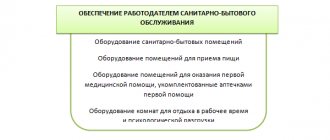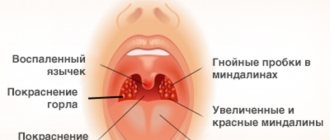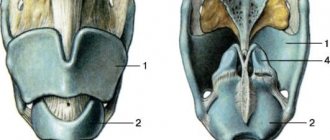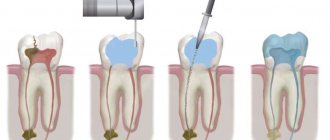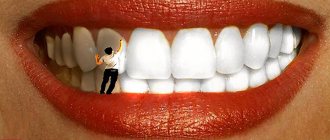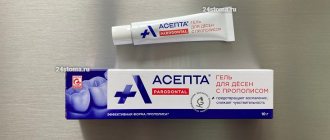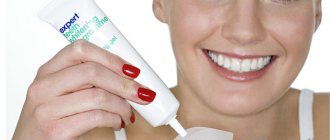What are tonsils, structural features
The immune system consists of many components. They participate in the formation of the body’s immune response to pathogenic agents when attempting to introduce them. The tonsils are considered an important part of it. They are accumulations of lymphoid tissue. The tonsils are located in the mucous membrane lining the pharynx. Formations become the first filter on the path of infection into the body.
Together with other accumulations of lymphoid tissue, they form the pharyngeal ring. Tonsils have a complex structure. They are pierced by winding deep channels called crypts. Branching reaches the third or even fourth order. Their number is usually from 16 to 18 pieces. The epithelium covering the walls of the crypts is associated with lymphoid tissue over a large area.
These formations are most developed in the area of the upper pole of the tonsil. In their lumen, desquamated epithelial cells, food debris, leukocytes, and lymphocytes accumulate. Bacteria actively multiply in this environment. This structure promotes the development of chronic inflammatory processes inside the crypts.
Advantages of treatment at an ENT center
Treatment of ear, nose and throat diseases at the ENT CENTER is a comprehensive and individual approach to each patient. By making a preliminary appointment on the medical center’s website or by phone, you can:
- get face-to-face consultation with a specialist;
- undergo treatment of ENT diseases using progressive techniques;
- receive recommendations for further conservative treatment and prevention of ENT diseases.
Contact the ENT CENTER : here they will help you solve any problem within the competence of ENT doctors as efficiently, safely, quickly and painlessly as possible.
Methods for treating inflammation of the tonsils
Chronic tonsillitis is usually treated using conservative and surgical methods, which are used only as a last resort.
The following types of therapy are used:
- antibiotic therapy prescribed by otolaryngologists taking into account the sensitivity of bacteria; treating the throat with antiseptic solutions (“Octenisept”, “Miramistin” and others); antihistamines to relieve swelling of the mucous membrane; immunomodulators to stimulate the immune system; painkillers.
The patient must strictly follow a diet. Exclude solid foods, cold or hot dishes and drinks, alcohol, soda.
Indications
Most often, washing the lacunae of the tonsils is prescribed by an otolaryngologist in cases where characteristic symptoms appear in a child with acute tonsillitis or relapse of chronic tonsillitis in order to:
- get rid of the purulent-inflammatory process,
- relieve symptoms of the disease (sore throat),
- sanitize the tonsils as a source of infection throughout the body.
As a result, washing the tonsils allows you to speed up recovery and reduce the risk of complications.
Self-washing of the tonsils in children is unacceptable, since you can injure the delicate walls of the tonsils with inept movements and fail to carry out a high-quality antiseptic treatment, which will aggravate the patient’s condition.
What methods of hardware washing of tonsils are there?
Washing the tonsils is a procedure that is performed only by an ENT doctor. This can be done in several ways:
- Using a special syringe. During the procedure, the doctor uses a syringe with a curved metal tube attached to it. It is introduced into the lacuna. This breaks the traffic jams. The syringe contains a solution of an antiseptic - furacillin, potassium permanganate and others. Liquid is pumped into the lacuna. It pours out, squeezing out pus. Vacuum washing method. Removal of purulent plugs occurs under the influence of ultrasound. Radiation promotes the penetration of drugs into deep lacunar passages. This type of washing can produce almost complete cleansing of lacunae. Cavitation method combined with ultrasound. When ultraacoustic vibrations pass through a liquid, cavities with air are formed in it. When they collapse, a shock wave is formed. It damages the cell membranes of bacteria.
Using these techniques, together with drug therapy, it is possible to achieve a significant reduction in exacerbations of chronic tonsillitis.
Side effects from rinsing
Side effects that may occur as a result of rinsing:
- Damage to the mucous membrane.
- Allergic reactions to medications used during rinsing. Sometimes allergies appear already during the first interventions, and sometimes only after several procedures, as the allergen accumulates. Allergic reactions can manifest themselves both locally (swelling and hyperemia) and systemically (urticaria, anaphylaxis). In any case, the medicine used should be changed.
- Spread of infection from the tonsils to the mucous membrane of the mouth, pharynx, and respiratory tract. Sinusitis and bronchitis may develop. The risk increases if the rinsing is done independently, and is minimal with the vacuum method.
- Rarely, but possible exacerbation of tonsillitis up to an increase in temperature to 40°C, with inflammation of the lymph nodes and general intoxication.
Washing the palatine tonsils is a fairly effective and low-traumatic method of treating chronic tonsillitis compared to tonsil removal. Especially if you do the washing in highly qualified clinical diagnostic centers under the supervision of specialists. Unfortunately, it is not always possible to completely cure a patient of chronic tonsillitis with the help of rinsing. But in any case, the condition improves, exacerbations become less frequent, and in most cases it is possible to avoid tonsil removal.
Hardware methods cost slightly more than traditional methods using a syringe, but the effect is incomparably higher, and side effects are kept to a minimum. Moreover, you should not wash your tonsils at home, since maintaining sterility is not always possible, and the risk of injury and spread of infection is very high.
Indications and contraindications for washing the tonsils
Most often, the procedure is performed to treat chronic forms of tonsillitis in adults. The doctor decides whether this procedure is necessary for the patient. The main indication is the presence of purulent plugs in the lacunae of the tonsils.
Contraindications for treatment are as follows:
- state of exacerbation of inflammatory processes; oncological processes; pathologies of the retina; severe heart defects; decompensation of hypertension.
This manipulation is not recommended for pregnant women and children under three years of age.
Contraindications
Contraindications:
- acute processes in the nasopharynx (acute tonsillitis, rhinitis, caries, stomatitis and others);
- the presence of decompensated chronic diseases of the cardiovascular system;
- retinal detachment;
- presence of cancer;
- children under 3 years of age;
- pulmonary tuberculosis in the active stage;
- history of allergic reactions to medications used for rinsing;
- I and III trimesters of pregnancy.
Regardless of how the procedure is carried out, a number of conditions must be met:
- take a nasal and throat swab test for bacteriological culture;
- do not eat or drink 1.5-2 hours before the procedure to reduce the likelihood of vomiting;
- since during rinsing you will have to breathe through your nose, if there is congestion, it is necessary to instill vasoconstrictor drops;
- after rinsing, avoid eating rough food so as not to irritate the sore throat;
- If severe pain occurs during and after the procedure, repeated rinsing should be done with freezing.
How is the tonsil rinsing procedure performed?
No special preparation is required before performing this procedure. Washing on this device occurs in several stages:
- first, the tonsils are treated with lidocaine; a vacuum attachment is fixed to the surface of the formation; the device creates negative pressure; the nozzle pulls out purulent plugs and removes them into a special container; the lacunae are washed with an antiseptic solution. Ultrasound injects a drug into the tonsil.
The procedure relieves inflammation, activates tissue regeneration, and removes swelling.
Vacuum method
To carry out the manipulation, an ultrasonic device “Tonsillor” is used. As standard, the device comes with a vacuum nozzle for washing gland lacunae. At the beginning of the manipulation, the ENT doctor performs topical anesthesia of the palatine tonsils with a solution of Lidocaine. The patient sits comfortably in a chair and opens his mouth.
The vacuum nozzle is brought to the surface of the tonsils and attached to it. The washing solution is fed through a nozzle, passes through the gaps and, under pressure, washes out all the pathogenic contents from them. Antiseptic or saline solutions are used as flushing solutions. The solution passes through the thickness of the tonsil once and is not reused, since after washing it is removed into a special suction.
Since the waste solution goes directly into the suction, infection of healthy tissues during the manipulation is excluded.
The procedure is carried out under the influence of ultrasonic vibrations, which allows the medicine to penetrate deeper layers of tissue, and this contributes to a rapid recovery.
In general, the procedure on the Tonsillor apparatus resembles the principle of operation of a vacuum cleaner. This vacuum sanitation allows you to effectively clean the lacunae of the tonsils and get rid of purulent accumulations.
On average, five to ten sessions are required to achieve a lasting therapeutic effect.
At this point we could put a full stop and end the article. But there is another way to carry out vacuum rinsing - using a modified attachment of the Tonsillor device, which is used only in the ENT Clinic of Doctor Zaitsev.
Advantages of carrying out the procedure at the RebenOK clinic
Consultation and appointment of experienced specialists will help get rid of the symptoms of sore throat and prevent the development of complications. An experienced ENT specialist will rinse the child’s tonsils and prescribe comprehensive treatment, based on the results of the diagnosis. We work at affordable prices, providing services in full compliance with international protocols.
Advantages of carrying out the procedure at the RebenOK clinic:
- High efficiency indicators. Specialists use a modern Tonsillor device, which removes purulent plugs using optimal water pressure.
- Guaranteed safety. The washing procedure is carried out extremely carefully, which eliminates the possibility of injury to the tonsil tissue.
Doctors pay special attention not only to the result of treatment, but also to the process itself.
To eliminate gagging and pain during the procedure, local anesthetics are used. Sign up to wash your child’s tonsils in Moscow at the ENT office of our medical center. We carry out a cleansing procedure and prescribe comprehensive treatment, which allows us to avoid the development of complications that are dangerous to health and life.
Systemic therapy for the treatment of chronic tonsillitis at IAKI LLC
Washing the lacunae of the tonsils in combination with physiotherapeutic procedures has a good therapeutic effect and is widely used at the Institute.
First stage (washing the lacunae of the tonsils)
1. Washing of the tonsils can be done using the Belogolov’s method (Fig. 1) and using hardware methods (using the ATMOS ENT combine (Fig. 2) and the Tonsilor-M apparatus, etc.).
The choice of method depends on diagnostic and therapeutic purposes and is determined by an otorhinolaryngologist.
The antiseptic pressure created by the syringe piston effectively removes large purulent plugs. The disadvantage of the method is that it is traumatic when there is a pronounced gag reflex and the inability to qualitatively clean lacunae of small and medium diameter from purulent caseous contents. This method is widely used when it is necessary to obtain material for diagnostics, as well as for certain anatomical features of the structure of the palatine tonsils.
Rice. 1. Washing according to Belogolov’s method
2. Rinsing the lacunae of the palatine tonsils with a vacuum apparatus “ATMOS” (Fig. 2).
During rinsing, vacuum action allows you to effectively and painlessly remove even purulent plugs located deep in the lacunae. The method is non-traumatic and suitable for treatment in all age groups (vacuum attachments are selected taking into account the age and size of the tonsils). During rinsing, the tonsil is treated with an antiseptic solution.
3. Vacuum rinsing of the palatine tonsils with the “Tonsilor-M” apparatus (Fig. 2)
One of the advanced and effective methods of conservative treatment of chronic tonsillitis. The principle of operation of the Tonsilor-M device is based on creating a vacuum at the point of application and emitting low-frequency ultrasound onto the affected tissue of the palatine tonsil. Ultrasonic waves provide cavitation and aspiration of purulent contents from the lacunae of the tonsils, accelerate regeneration processes without causing allergic reactions or addiction, enhancing the therapeutic effect. The device is equipped with special nozzles that allow you to deliver an antiseptic solution directly to the tonsils.
Rice. 2. Washing using an ENT combine “ATMOS”, a device “Tonsilor-M”
Second stage (treatment with an astringent antiseptic solution)
After washing the lacunae of the palatine tonsils and clearing them of purulent contents, the tonsil tissue is soaked with a tampon with an astringent antiseptic agent (Fig. 3).
Rice. 3. Treatment of tonsils with an antiseptic solution
Third stage (laser therapy)
The next stage is a physiotherapeutic effect on the tissue of the palatine tonsil (Fig. 4) using a low-intensity ultraviolet laser beam, aimed at reducing swelling and inflammation of the tissue of the palatine tonsils.
Rice. 4. Laser therapy session after rinsing
Fourth stage (transdermal (percutaneous) exposure to an infrared magnetic laser)
Next, a transdermal (percutaneous) effect of an infrared magnetic laser (Fig. 5) is performed on reflexogenic ENT points: the maxillary region of the projection of the palatine tonsils, the region of the larynx and thyroid cartilage and the projection region of the exit site of the second branch of the trigeminal nerve on the face.
Rice. 5. Transdermal (percutaneous) exposure to an infrared magnetic laser
Fifth stage (vibroacoustic impact)
It is recommended to conduct sessions of vibroacoustic influence; the use of this method is necessary to improve the trophic (nutritional) function and normalize microcirculation in the tissues of the palatine tonsils.
Stage six (therapeutic low-intensity laser exposure)
In some cases, in the treatment of chronic tonsillitis, it is possible to alternate a therapeutic low-intensity laser (Fig. 7, Fig. 8) with other types of physiotherapeutic effects: ultraviolet irradiation (UVR, “quartz tube”) of the mucous membranes of the ENT organs and vibroacoustic effects on the projection area of the palatine tonsils.
This method allows for the sanitation of the microflora located on the surface of the palatine tonsils and the nasal cavity due to ultraviolet irradiation (UVR).
Rice. 7. Sanitation of the microflora of the nasal cavity using ultraviolet irradiation.
Rice. 8. Sanitation of microflora on the surface of the tonsils using ultraviolet irradiation.
Systemic therapy for chronic tonsillitis is carried out in courses (usually spring, autumn). The number of procedures is determined by an otorhinolaryngologist. For a lasting effect to occur, at least five sessions must be performed. If, during the procedure, purulent caseous contents continue to be washed out of the lacunae of the palatine tonsils, the washing procedures must be continued “until clean rinsing waters”. Typically the course duration is 10 procedures.
It is advisable to conduct courses 2 to 4 times a year; between courses it is necessary to carry out medication prescribed by an ENT doctor.
A course of washing the tonsils not only reduces the risk of exacerbation of chronic tonsillitis, but also prevents the occurrence of other ENT pathologies, and also avoids the need to remove the tonsils.
Attention! If, after completing the course, the formation of purulent caseous contents occurs 2-4 weeks later, the doctor may recommend surgical removal of the tonsils.
With systemic therapy, surgical treatment methods are rarely used!
The consequences of chronic tonsillitis most affect the heart and joints! Rheumatism of the joints, inflammation of the myocardium, endocardium can be a consequence of chronic tonsillitis! DO NOT SELF-medicate! CONTACT AN OTOLARINGOLOGIST!
It is not recommended to use antibacterial drugs in the chronic process, however, in the acute period there is a need for their use.
Attention!
The selection of drug therapy should be made individually, taking into account the severity of the disease, the presence of concomitant diseases, the patient’s age and the risk of possible side effects. Strictly follow the instructions of the otorhinolaryngologist! We ask you not to self-medicate based on Internet data!
Branch phone:
+7 (495) 695-56-95
Procedure options
Rinsing with water or solutions. The procedure is carried out with a special device - an irrigator. It allows you to regulate the liquid pressure from the weakest to the most intense. Under the pressure of the jet, pus quickly comes out of the tonsils.
Vacuum washing. A more advanced medical procedure. It is carried out using the Tonsilor device, which works thanks to ultrasound. The tonsil tissues are impregnated with special agents through low-frequency phonophoresis.
The cost of washing the tonsils using both methods in our clinic in Moscow is the same. You can see our price list on this page. The decision to choose a method is made by the doctor based on the characteristics of the patient’s health condition.
